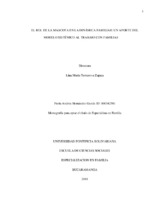Mostrar el registro sencillo del ítem
El rol de la mascota en la dinámica familiar: un aporte del modelo sistémico al trabajo con familias
| dc.contributor.advisor | Terranova Zapata, Lina María | |
| dc.contributor.author | Hernández García, Paola Andrea | |
| dc.coverage.temporal | 2018 | |
| dc.date.accessioned | 2020-05-12T16:33:14Z | |
| dc.date.available | 2020-05-12T16:33:14Z | |
| dc.date.issued | 2018 | |
| dc.identifier.uri | http://hdl.handle.net/20.500.11912/5359 | |
| dc.description | 55 páginas | spa |
| dc.description.abstract | Atendiendo la realidad actual, donde un sin número de familias se han dado en apertura hacia un nuevo y distinto miembro no humano, la presente monografía se planteó con el interés de describir el rol que cumple la mascota en la dinámica familiar, como aporte del modelo sistémico al trabajo con familias. De ahí que se propuso partir de la identificación de tipologías y el ciclo vital familiar en las que este miembro se encuentra, ello con el fin mismo de clasificar el rol y evidenciar el significado, como aparición de la mascota en el genograma familiar desde la incidencia en la calidad de vida de las familias. Efectivamente desde la respectiva revisión documental que incluyó como áreas de estudio la psicología y antro zoología, se destaca la participación de la mascota en procesos de triangulación, donde desde la tipología familiar en que se encuentre llega a situarse bajo el rol de hijo, hermano entre otros a razón del vínculo y aportes biopsicosociales al sistema y subsistemas. En definitiva, se reconoce como características de las familias que conviven con mascotas la flexibilidad y adaptación al cambio, a la vez que se convierten en espacio de democratización en el que cada miembro desde la referencia de demandas de la mascota, considera y se organiza a fin de cumplir con la satisfacción de necesidades de la misma. | spa |
| dc.description.abstract | Considering the current reality, where a number of families have opened up to a new and different non-human member, the present monograph was raised with the interest of describing the role played by a pet in family dynamics, as a contribution of the systemic model to the work with families. Hence, it was proposed to start from the identification of typologies and the family life cycle in which this member is located, with the purpose of classifying the role and evidencing the meaning, as a result of the appearance of the pet in the family genogram starting from the incidence in the quality of life of families. Effectively from the respective documentary review that includes as areas of study the psychology and antrum zoology, the participation of the pet in triangulation processes is highlighted, where from the family typology in which it is found it is placed under the role of son, brother among others because of the bond and biopsychosocial contributions to the system and subsystems. In short, it is recognized as the characteristics of families that coexist with pets, flexibility and adaptation to change, while becoming a space of democratization in which each member from the reference of the demands of the pet, considers and organizes in order to fulfill the satisfaction of needs of the same. | eng |
| dc.format.mimetype | application/pdf | |
| dc.language.iso | spa | |
| dc.publisher | Universidad Pontificia Bolivariana | spa |
| dc.rights | Attribution-NonCommercial-NoDerivatives 4.0 International | * |
| dc.rights.uri | http://creativecommons.org/licenses/by-nc-nd/4.0/ | * |
| dc.title | El rol de la mascota en la dinámica familiar: un aporte del modelo sistémico al trabajo con familias | spa |
| dc.type | Especialización | spa |
| dc.publisher.department | Escuela de Ciencias Sociales | spa |
| dc.publisher.program | Especialización en familia | spa |
| dc.type.hasVersion | publishedVersion | spa |
| dc.description.sectional | Bucaramanga | spa |
| dc.description.degreename | Especialista en familia | spa |
Ficheros en el ítem
Este ítem aparece en la(s) siguiente(s) colección(ones)
-
Trabajos de grado [6698]
Monografías, artículos, informes, proyecto de grado


